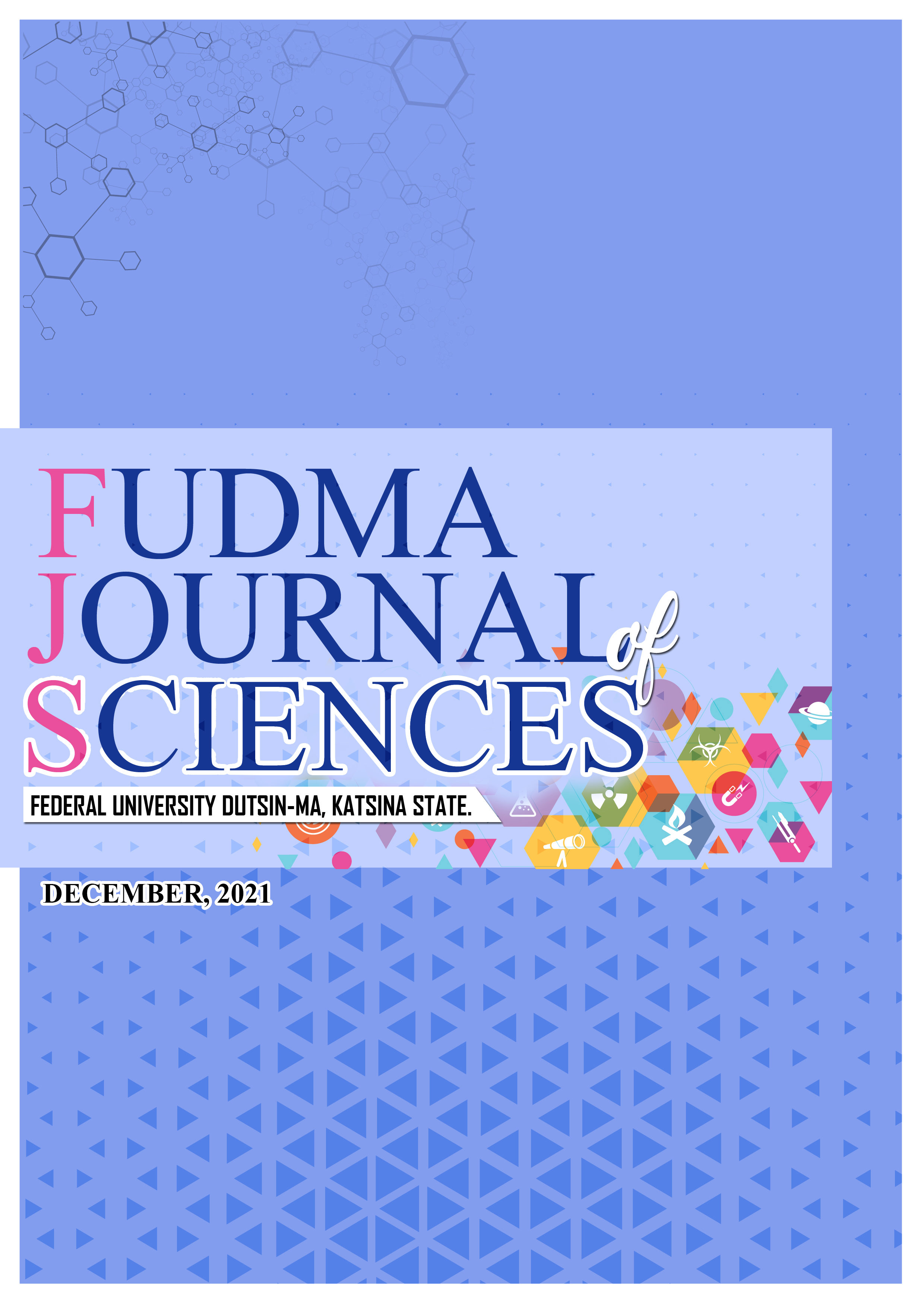ANTIMICROBIAL AND ANTIOXIDANT ACTIVITY OF SOME TRANSITION METAL COMPLEXES OF TWO LIGANDS DERIVED FROM AMINO ACIDS AND 2 – IMINO – 1 – METHYLIMIDAZOLIDIN – 4 – ONE
DOI:
https://doi.org/10.33003/fjs-2021-0504-702Keywords:
antioxidant; antimicrobial; metal complexes; amino acids; ligands.Abstract
Plant extracts are most of the time used for antioxidant and antimicrobial studies. The Present study was designed to evaluate the activity of metal complexes as antioxidant and against some selected bacterial and fungal isolates. The new metal complexes of Cr (III) and Zn (II) containing ligands derived from Tyrosine, Leucine and 2 – imino – 1 – methylimidazolidin – 4 - one were selected. The test compounds were evaluated for their possible antioxidant activity through free radical scavenging activity via using 1,1 – diphenyl – 2 – picryl – hydrazyl (DPPH) method. All the complexes exhibited good to moderate activity with Cr (III) complex (CrL1) and (CrL2) as the best radical scavengers having the % inhibition value of 67.74 and 65.33 respectively. The complexes were also screened for their antimicrobial activities against two bacterial isolates and one fungal isolate (Streptococcus pneumoniae, Klebsiella pneumoniae and Aspergillus niger). The result showed that all the compounds have the moderate activity against the tested organisms.
References
Agbaje O. Osowole A.A, Malumi; E.O and Wakil SM (2015), Synthesis, spectroscopic characterization, antimicrobial and antioxidant properties of some metal (ii) complexes of mixed ligands – riboflavin and 4 – Aminobenzoic acid, research and review journal of chemistry. 14(2):1905 – 1933.
Aiyelabola T., Akinkunmi E., Obuotor E, Olawuni I, Isabirye D and Jordaan J (2017), Synthesis, characterization and Biological activities of coordination compounds of 4-Hydroxy-3-nitro-2H-chromen-2-one and its aminoethanoic acid and pyrrolidine-2-carboxilic acid mixed ligand complexes, Bioinorganic chemistry and Application. 10(1155):1-16.
Al-noor T.H and Abdul Karim L.K (2015). Synthesis, characterization and Anti-Bacterial Activities of Co (II), Ni (II), Cu (II), Cd (II) and Hg (II) mixed ligand complexes of L-leucine and trimethoprim antibiotic: chemistry and material research: 7(3):32-39
Aurora Reiss, Stelian Florea, Theodor Caprouio, Nicolae Stanica (2009), synthesis characterization and antibacterial activity of some transition metals with the Schiff base N-(2-furanyimethylene)-3-aminodibenzofuran, Turk J Chem. 33 (2009), 775 – 783.
Cheesbrough M. (2008) District laboratory practice in tropical countries. Press syndicate publishers, University of Cambridge, Edinburgh Cambridge United Kingdom. 194 – 204.
Gurbuz D, Cinarli A, Tavman A and Tan B.S (2015), Synthesis characterization and antimicrobial activity of some transition metal complexes of N-(5-Chloro-2-hydroxyphenyl)-3-methoxy-salicyladimine; Chemical society of Ethiopia. 29(1): 63 – 74.
Hadjer F, Tahar B, Djallal A, Eddine, and Sofiane D (2018), Antioxidant and antimicrobial activity of some transition metal complexes with non – natural Amino acids used As ligand: Journal of materials and environmental sciences 9 (7) :2153 – 2157.
Islam M.N shariar S.M.S, Islam M.K, Jesmin M, Ali M.M, Khanam J.A (2013), antibacterial activities of some transition metal Schiff base complexes: international letters of chemistry, physical and astronomy, 10:12-20.
Mannir M, Nura S.G and Jabiru M (2020), Solvent – Free synthesis and evaluation of antimicrobial activity of Vanadium (III) metal complex using two amino acids as mixed ligands, International journal of innovative research and Development. 9(9):173 – 178.
Muhammad M and Kurawa M.A (2019): “solid state synthesize characterization and antimicrobial studies of Ni (11), Co (11), and Cu (11) complexes 1-(4-nitropheny1) imino] methy1) naphthalen-2-ol†Chemsearch journal. 10 (1):38 -45
Oriel S, Sorenlis G, R.H.P, Angel L, Yokoy, David C, Mercedes F, Peter T, Izaskun U, Hector R.R Joseph T.O, William C, Maria C.G (2016), polyhedron: 110:14-23.
Sani S and Lawal AM (2017): Liquid – assisted mechanochemical synthesis: green Approach to synthesis of Co (11) Schiff base complex and of antimicrobial activities†international journal of innovative research and development. 6(12)79-86
Sarika V, Sarita S and Poonam R. (2012), Synthesis and spectroscopic studies of mixed ligand complexes of transition and inner transition metals with a substituted benzimidazole derivative and RNA bases. J. Chem. Pharmaceut. Res. 4(1): 693 – 699.
Selvaganapathy M and Raman N (2016); Pharmacological Activity of a few Transition metal complexes: A short Review, Journal of chemical Biology and Therapeutics. 1(2):1-17.





